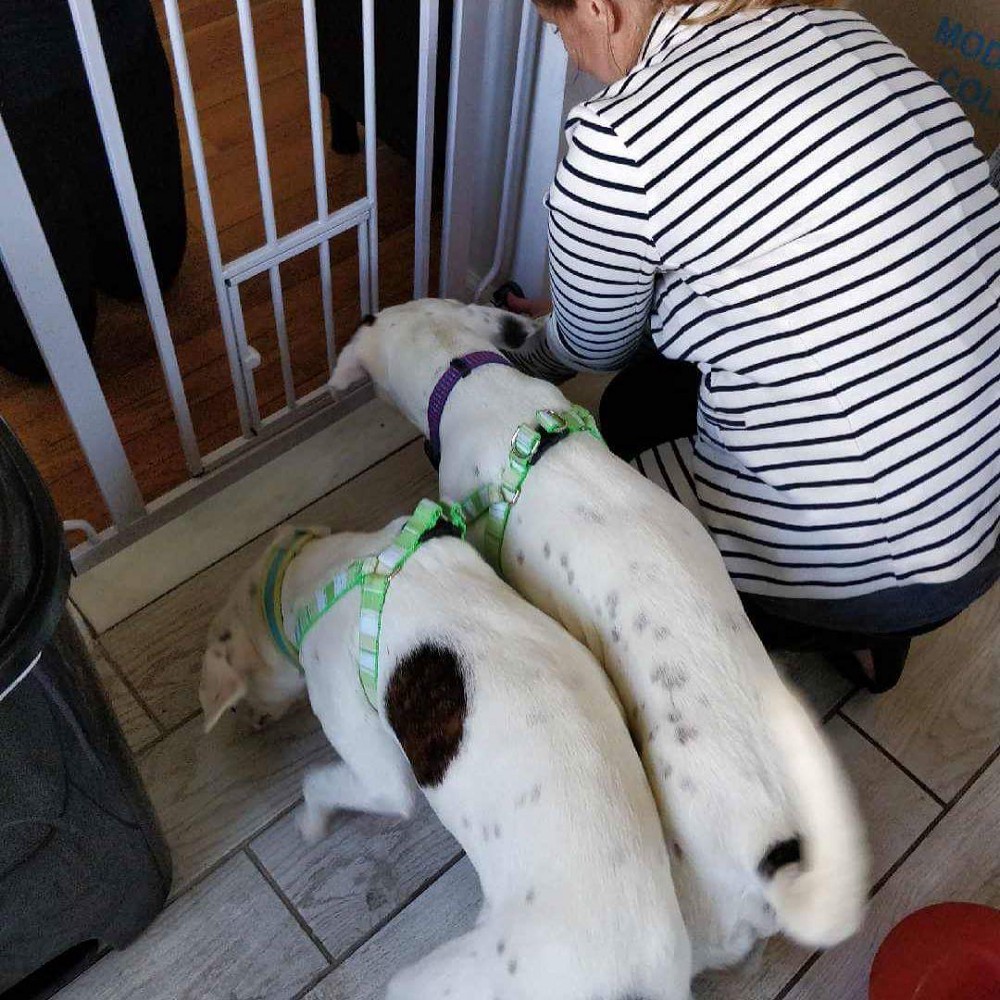Whether you are planning on adopting a dog during the Clear the Shelters event August 18th, or have already welcomed a dog home, we have your back!
Housetraining
No matter how old your newly adopted dog is, give her extra potty breaks. Housetraining doesn’t always transfer seamlessly from one place to another. Err on the side of caution and give more potty breaks than needed. Reward with treats immediately after the dog eliminates, don’t wait until the dog is back inside. If you reward inside, too much time has passed and your dog is associating going inside with the reward rather than eliminating.
Want to teach your dog to potty quickly? Trust me, you do. A lot of dogs learn to hold their pee/poo until the end of the walk because pottying is associated with ending the walk. Instead, go for a walk after your dog eliminates. Your dog will learn to hurry up and potty so she can start her walk!
Secure the Perimeter
Newly adopted dogs can be flight risks and escape artists. Keep your car windows closed. No off-leash privileges until you’ve trained a recall to fluency. Inspect fences and gates for integrity and gaps. You may be surprised by how little room is needed for a motivated dog to squeeze through.
Watch your dog when she’s in the fenced yard. Make sure your dog can’t get over or under a fence. My terrier mix checks the perimeter of every new yard she’s in. She pushes on the fence just like the dinosaurs in Jurassic Park. Do terrier mixes have dino DNA?
Take extra care at the front door. Some dogs may try to squirt through your legs to go on walkabout. You may want to put your dog in a crate, behind a baby gate, or in a part of your home inaccessible to the front door. This also applies whenever you are having guests over. (My husband and I put our cat in a room whenever we host a gathering so he doesn’t convince our guests he’s an outdoor kitty when he’s most definitely not.)
Amy installs baby gates in Carter and Wayne's foster home
Let Your Home do the Training
Get down on your knees and look at your home from your dog’s perspective. What might look benign to you may be irresistible to a dog. We used to have to unplug lamps and place all wires out of reach or else our terrier mix would chew on them. We didn’t have to do that for very long before she was able to leave wires alone.
Put away throw pillows, remote controls, tissue boxes, shoes, and laundry. On the bright side, while you are limiting your dog’s chewing choices, dusting and vacuuming will be much easier! Yes, your home may look a bit boring for a while. By limiting her access to non-dog items, you’re teaching her the good habit of only playing with and chewing on her toys.
Don’t forget to stash meals in the oven instead of leaving countertops and dining tables unattended!
Meet and Greets
Jackie reinforces Carter and Wayne for sitting instead of jumping
As excited as you are to show off your new furry family member, please do not invite friends and family over to meet her until you get to know your dog better. She may be a “Buy me a drink and get to know me first” kind of dog. For the time being, avoid people and dogs as much as you are able on walks. We realize this is especially difficult in urban areas and with exceptionally cute dogs. Behavior United LLC or a force-free trainer in your area can teach you attention games to play with your dog to suppress the SQUIRREL! moments. Teach your dog polite greetings, like sitting when approached, instead of jumping on people.
Consistency is Kindness
Everyone in the family should agree to canine privileges. Is the dog allowed on the couch or bed? It’s up to you, just be consistent. Make a list of rules that everyone agrees to follow. Start a routine that works for you during the work week and on weekends. It is kinder to be consistent than to constantly change the rules. Hire Behavior United LLC or a force-free trainer in your area to help your dog transition from shelter to home. After hiring a private trainer to help with the transition, sign up for a group force-free training class.
Congratulations on welcoming your dog home! A must read for newly adopted dogs is Dr. Patricia McConnell’s Love Has No Age Limit. May nothing in your home be damaged, may your dog never be lost, and may every day with your dog be the best day ever.



